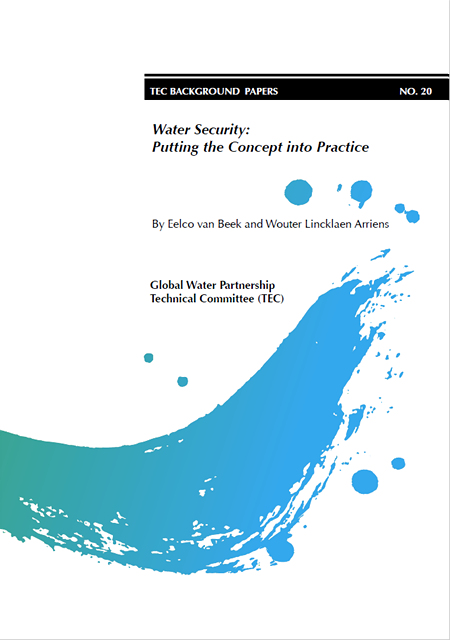Water Security: Putting the Concept into Practice
| Category | Water Security |
|---|---|
| Department | Global Water Partnership Technical Committee (TEC) |
| Published Date | 2014 |
| Author | Eelco van Beek and Wouter Lincklaen Arriens |
| Publisher | Global Water Partnership (GWP) |
| Pages | 55 |
| Language | English |
| ISBN | 978-91-87823-07-7 |
본문

Find at: https://www.gwp.org/globalassets/global/toolbox/publications/background-papers/gwp_tec20_web.pdf
FOREWORD
The concept of water security has wide intuitive appeal as it expresses the main goal of water management, which is to improve the quality of life for everyone. It is a concept that provides politicians, business leaders, water professionals, and many different disciplines and interest groups with a common language. Water security is a starting point for negotiating the complexities of allocating limited water resources among many competing and often conflicting demands.
A water secure world is one where every person has enough safe, affordable, clean water to lead a healthy and productive life and where communities are protected from floods, droughts, and water-borne diseases. Water security promotes environmental protection and social justice by addressing the conflicts and disputes that arise over shared water resources. This is the Global Water Partnership’s vision and, over the past 20 years, researchers and practitioners have sought to understand the economic, social, and environmental implications of increasing water security and what this means in practice.
There is now growing international consensus for increasing water security in a sustainable manner and for building more resilient and robust water systems and so the concept of water security is rapidly evolving from a vision to a development imperative. However, as yet there is no consensus on how to frame, approach, and operationalise what is a real and complex problem.
This landmark paper addresses these real issues. It brings together a wealth of information on what water security means and how to put this concept into practice. It discusses the many different ways in which it is currently being framed and operationalised through developmental and risk-based approaches. It describes the journey over the past two decades in which the process of integrating water resources management has developed and is reaching adulthood. People are beginning to see water management as a crosssectoral issue which includes water for people, food, ecosystems, and industry, and they are looking ahead towards sustainable resource use and ‘the future we want’.
But we cannot manage what we cannot measure and so measurement will be fundamental to increasing water security. This means identifying its various dimensions, setting targets, and seeking actions to achieve them. Thus, the final part of this paper deals with quantifying water security to enable practitioners to focus on current problems and set targets for improvement, assess the effect of planned measures, compare progress against benchmarks and experiences elsewhere, and learn lessons from good practice.
My thanks to the authors of this paper, Eelco van Beek and Wouter Lincklaen Arriens, who are members of the GWP Technical Committee for their comprehensive analysis of water security and its challenges and for setting down a clear pathway towards a more water secure world. I also extend thanks to the members of the GWP Technical Committee for their invaluable comments and suggestions during the preparation of this paper. I also wish to express appreciation for the editing support provided by Melvyn Kay.
Dr Mohamed AIT KADI
Chair, GWP Technical Committee










